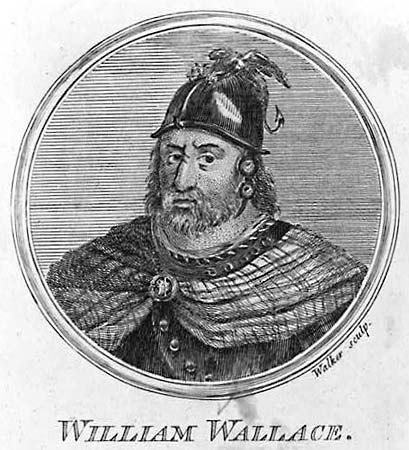Wallace, Sir William
Scottish hero
born c. 1270, , probably near Paisley, Renfrew, Scot.
died Aug. 23, 1305, London, Eng.
 one of Scotland's greatest national heroes, leader of the Scottish resistance forces during the first years of the long, and ultimately successful, struggle to free Scotland from English rule.
one of Scotland's greatest national heroes, leader of the Scottish resistance forces during the first years of the long, and ultimately successful, struggle to free Scotland from English rule.His father, Sir Malcolm Wallace, was a small landowner in Renfrew. In 1296 King Edward I of England deposed and imprisoned the Scottish king John de Balliol and declared himself ruler of Scotland. Sporadic resistance had already occurred when, in May 1297, Wallace and a band of some 30 men burned Lanark and killed its English sheriff. Wallace then organized an army of commoners and small landowners and attacked the English garrisons between the Rivers Forth and Tay. On Sept. 11, 1297, an English army under John de Warenne, earl of Surrey, confronted him at the Forth near Stirling. Wallace's forces were greatly outnumbered, but Surrey had to cross a narrow bridge over the Forth before he could reach the Scottish positions. By slaughtering the English as they crossed the river, Wallace gained an overwhelming victory. He captured Stirling Castle, and for the moment Scotland was nearly free of occupying forces. In October he invaded northern England and ravaged the counties of Northumberland and Cumberland.
Upon returning to Scotland early in December 1297, Wallace was knighted and proclaimed guardian of the kingdom, ruling in Balliol's name. Nevertheless, many nobles lent him only grudging support; and he had yet to confront Edward I, who was campaigning in France. Edward returned to England in March 1298, and on July 3 he invaded Scotland. On July 22 Wallace's spearmen were defeated by Edward's archers and cavalry in the Battle of Falkirk, Stirling. Although Edward failed to pacify Scotland before returning to England, Wallace's military reputation was ruined. He resigned his guardianship in December and was succeeded by Robert de Bruce (later King Robert I) and Sir John Comyn “the Red.”
There is some evidence that Wallace went to France in 1299 and thereafter acted as a solitary guerrilla leader in Scotland; but from the autumn of 1299 nothing is known of his activities for more than four years. Although most of the Scottish nobles submitted to Edward in 1304, the English continued to pursue Wallace relentlessly. On Aug. 5, 1305, he was arrested near Glasgow. Taken to London, he was condemned as a traitor to the king even though, as he maintained, he had never sworn allegiance to Edward. He was hanged, disemboweled, beheaded, and quartered. In 1306 Bruce raised the rebellion that eventually won independence for Scotland.
Many of the stories surrounding Wallace have been traced to a late 15th-century romance ascribed to Henry the Minstrel, or “Blind Harry.” The most popular tales are not supported by documentary evidence, but they show Wallace's firm hold on the imagination of his people. A huge monument (1861–69) to Wallace stands atop the rock of Abbey Craig near Stirling.
Additional Reading
Biographies include James Fergusson, William Wallace, Guardian of Scotland, new ed., rev. (1948); and Andrew Fisher, William Wallace (1986).
- Charles Emmanuel II
- Charles Emmanuel III
- Charles Emmanuel IV
- Charles E. Spearman
- Charles Eugene Bedaux
- Charles, Eugenia
- Charles-Eugène Delaunay
- Charles Eugène Foucauld, vicomte de
- Charles Eugène, vicomte de Foucauld
- Charles Evans Hughes
- Charles E. Whittaker
- Charles, Ezzard
- Charles Fabry
- Charles Felix
- Charles-Ferdinand de Bourbon Berry, duc de
- Charles-Ferdinand de Bourbon, duc de Berry
- Charles Ferdinand Pahud de Mortanges
- Charles-Ferdinand Ramuz
- Charles F. Kettering
- Charles Fleetwood
- Charles Floquet
- Charles Follen Adams
- Charles Follen McKim
- Charles Fourier
- Charles Francis Adams